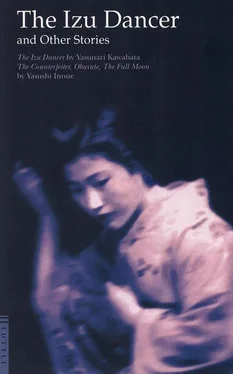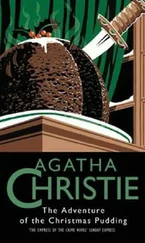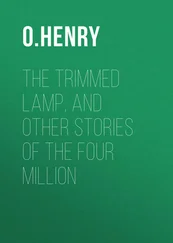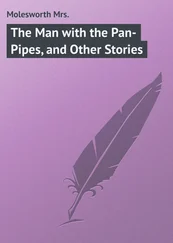Of course, this is something that had not occurred to me until then, but I did recall hearing at one time that Hosen Hara, if he can be called that, was adopted. In Hosen Hara's small native hamlet, situated on the Hino River which runs through the Chugoku mountain range, there are many people who bear the surname Shinozaki. Although I had never inquired about Hara's original surname, by putting two and two together I was able very early to arrive at the indisputable fact that this Shinozaki person and Hosen Hara were one and the same.
For two days I laid aside my pen and postponed the task of chronicling Keigaku Onuki's biography. I passed the time idly, sitting in a wicker chair on the veranda, facing south and gazing at the late-summer Amagi mountainside as the sunbeams were rapidly fading. My thoughts turned away from the image of the brilliant early days of the artistic genius Keigaku, and Hosen Hara's hapless career captured my thoughts. Then, for the first time, all my fragmentary bits of knowledge of him fell into place, and it was a composite picture of his life that now flashed into my mind. Filled with a strong impulse to think further about Hosen Hara, I turned my face toward the mountain. There was something compelling in Hosen Hara's life that forced me to think about him.
II
IN THE fall of 1943, I had set out with Takuhiko Onuki to take a look at some of Keigaku's representative early works which had been produced and still remained scattered in various villages near the artist's birthplace around the Inland Sea in Hyogo and Okayama Prefectures. This was the first time that I encountered the name of Hosen Hara.
We had set a period of five days to visit the homes of the collectors of Keigaku's works and had scheduled our trip in this order: Akashi, Kakogawa, Takasago, Himeji, Shikama, Aioi, Wake, and Saidaiji. Since Takuhiko had generally announced in advance that we were going to make these visits, we were hospitably received at most of the houses, and we were able to inspect many works of Keigaku's second decade, hitherto known to us only by name.
While we were quite busily getting on and off trains, the autumn sunbeams were scattered like fallen petals over the whitish sand characteristic of these places. As we got off at the small stations in the Harima-Bizen area, we had the feeling of being somewhere near the sea. We wandered about from house to house visiting the old homes and rich mansions of those who had been, in a sense, patrons of the late Keigaku, men who were written up in my notes. Because of our tight schedule, we had just one or two hours at some places. But even when we could have been more relaxed, I had to go half-galloping after the impetuous Takuhiko along the long pine-wooded roads and through the mud-walled residential areas. The late fall temperature was ideal, neither too hot nor too cold, but traveling at such a pace, our bodies were covered with a light perspiration. It had been my main purpose on this trip to see these works, and it was Taku-hiko's intention to pay his respects at the homes of his late father's powerful supporters. But at each of those homes, we had to listen to one or two anecdotes about Keigaku's early days, and occasionally, if there were scrolls in unauthenticated boxes, Takuhiko was asked to autograph them.
Takuhiko, whose resemblance to his father was manifest in the high-strung temperament that showed in his face, thick eyebrows, and crewcut hair, would say, "Fine, let's do it!"
And he would roll up his sleeves to his big-boned shoulders, not at all like "a fellow who did as he pleased in Paris and whose charm and polish were renowned throughout the world," as he often boasted, and he would show that he could write characters surprisingly like his father's.
From the time of our first encounter, I had taken a curiously great interest in this contemporary of mine, this Keigaku the Second, and in a short time we had built up a frank, candid, and friendly relationship. Although he had been something of a profligate abroad, playing around did not interest him after he returned to Japan. As if his personality had suddenly changed, he did not care about either his reputation or his appearance. He gave the impression of staring wide-eyed at war-ravaged Japan, like a foreigner. Coupled with his defiant nature as a second-generation genius, he had the good-natured attitude generally attributed to young men from good homes. Rumors that had reached my ears before I actually met him were incredibly far from the truth. It seemed as though he was being stereotyped through misunderstandings of the nature of a son of a well-known painter.
He had inherited a prodigious artistic talent from his father, but gossip had it that he was lazy, shiftless, and incompetent, that he was slovenly and undignified, and he was rumored to be an offensive, despicable playboy. While it could be said that he had a profession — he was an engraver — he actually didn't do much of anything. There was nothing compelling him to do anything, because he had inherited an enormous fortune, a magnificent town house, and a villa, all bequeathed by his father. Before the war ended in defeat, producing his father's biography and collecting his father's most magnificent works had been the most compelling jobs for him.
In the course of my five-day journey with this Taku-hiko Onuki, we stumbled upon one fact of completely unanticipated interest. As if by prearrangement, one forgery of Keigaku's work had been collected at almost every house.
The first forgery of Keigaku's work that we encountered was in Kakogawa, at the home of a Mr. M-, one of the artist's patrons, where the head of the household had passed away some time ago. In the inner drawing room, which looked out over a well-kept garden, we were shown any number of Keigaku's works, among which there was one miniature, a scroll in the
Chagake
style which usually adorns tea-ceremony rooms. The scroll was labelled "North Kyoto Autumn Scenery." The instant that this one was displayed, I could tell beyond question what it was. Even Takuhiko, who had been peering at it from a vantage point off on the side, immediately turned his eyes toward me. Our glances instinctively met and intertwined.
"What do you think?" his eyes were saying.
For my part, I knew the original of this same work, which was held by a collector in Kyoto. Although Takuhiko had never seen it before, he knew instinctively from its lack of dignity and grace that this was not Keigaku's. He explained this to me later. At any rate, by checking with photographs in exhibition catalogues and other reference works, we could tell definitely that this painting had been drawn in imitation of Keigaku's work. As an extra precaution, right then and there, we opened a book of impressions of Keigaku's seals and checked. It seemed quite clear that in place of the stone seal always used with Keigaku's professional name,
Tekishintei,
a counterfeit wooden seal had been substituted. At first glance, the seal impression was a perfect facsimile, but on comparison with the two together, there were distinct discrepancies. Besides, the vermillion inking-pad that was used was different from the pads used in originals. Also, while the painting was furnished with an autographed case, this too was, of course, a counterfeit. When asked, the widow of the deceased owner said that she was acquainted with the man from whom her husband had acquired it; that he was a Japanese painter who carried old curios around with him; that she didn't know what he was doing now, but at that time he had briefly been living in Kakogawa; that he was a friend of Keigaku's called Hosen Hara.
When Takuhiko heard this, he exclaimed, "Did you say Hosen Hara! I know him too. Let's see. . when was that? At any rate, I vaguely remember meeting him two or three times when I was small. He certainly was a friend of my father's, and he used to come around to our house, but I once heard that he later became a counterfeiter of my father's works and my father forbade him to come again. So, that really was true!"
Читать дальше












